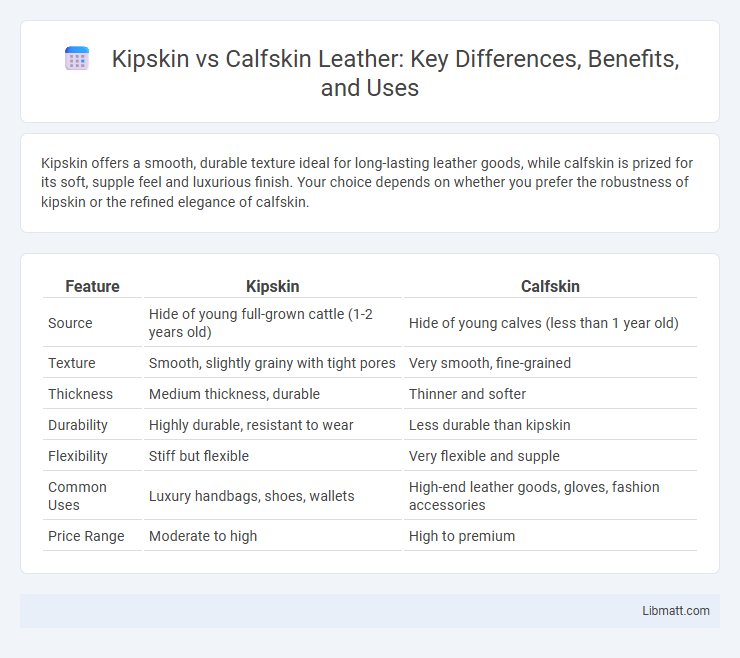Kipskin offers a smooth, durable texture ideal for long-lasting leather goods, while calfskin is prized for its soft, supple feel and luxurious finish. Your choice depends on whether you prefer the robustness of kipskin or the refined elegance of calfskin.
Table of Comparison
| Feature | Kipskin | Calfskin |
|---|---|---|
| Source | Hide of young full-grown cattle (1-2 years old) | Hide of young calves (less than 1 year old) |
| Texture | Smooth, slightly grainy with tight pores | Very smooth, fine-grained |
| Thickness | Medium thickness, durable | Thinner and softer |
| Durability | Highly durable, resistant to wear | Less durable than kipskin |
| Flexibility | Stiff but flexible | Very flexible and supple |
| Common Uses | Luxury handbags, shoes, wallets | High-end leather goods, gloves, fashion accessories |
| Price Range | Moderate to high | High to premium |
Introduction to Kipskin and Calfskin
Kipskin, derived from young cattle aged 6-12 months, offers a durable and smooth texture ideal for luxury leather goods, while calfskin, sourced from calves under six months, is prized for its soft, fine grain and supple feel. Both materials provide exceptional quality, but Kipskin tends to be thicker and more resilient, making it suitable for items requiring longevity, whereas calfskin excels in products emphasizing softness and elegance. Understanding the distinct characteristics of Kipskin and calfskin helps you choose the perfect leather for your specific fashion or accessory needs.
Origin and Source Differences
Kipskin leather comes from young cows typically aged six to twelve months, resulting in a finer grain and lighter texture compared to calfskin, which is sourced from newborn or very young calves for its smoothness and softness. Calfskin undergoes a delicate tanning process to enhance its suppleness, making it preferred for luxury goods, while kipskin is valued for its durability and slightly coarser feel. Understanding the origin of these leathers can help you choose the right material based on the desired balance between texture and strength.
Physical Characteristics Comparison
Kipskin is harvested from young cows, making it thinner and softer than calfskin, which comes from newborn calves and is denser with a firmer texture. Both leathers offer excellent durability, but kipskin's finer grain provides more flexibility and a smoother finish, ideal for luxury leather goods. Your choice between kipskin and calfskin depends on whether you prioritize supple softness or a robust, structured feel in the material.
Durability and Strength
Kipskin, derived from young cows aged 6-12 months, offers enhanced durability and strength compared to traditional calfskin due to its tighter grain and higher tensile strength. Calfskin, sourced from younger calves under six months, provides a softer texture but is generally less resistant to wear and tear over time. Both types are prized in luxury leather goods, yet kipskin outperforms calfskin in longevity and toughness for high-stress applications.
Texture and Appearance
Kipskin features a smooth, fine-grain texture with a slightly glossy finish, offering a sleek and polished appearance ideal for high-end leather goods. Calfskin showcases a softer, more supple feel with a natural matte look, characterized by subtle grain patterns that add depth and character to the leather. Your choice between Kipskin and calfskin depends on whether you prefer a refined, shiny surface or a more understated, elegant texture.
Common Uses in Industry
Kipskin is commonly used in luxury fashion accessories such as wallets, watch straps, and small leather goods due to its fine grain and durability. Calfskin finds widespread application in high-end footwear, handbags, and upholstery because of its smooth texture and versatility. Both materials are favored in the leather industry for premium products requiring a balance of softness and strength.
Cost and Value Analysis
Kipskin generally offers a higher cost compared to calfskin due to its durability and stronger grain, making it a preferred choice for premium leather products. Calfskin provides excellent value with a softer texture and more affordability, suitable for users seeking luxury on a budget. Your decision between kipskin and calfskin should balance the slightly higher investment in durability versus the softer feel and moderate price of calfskin.
Maintenance and Care Requirements
Kipskin requires moderate maintenance, including regular conditioning to prevent drying and cracking, as its fine grain is more delicate than calfskin. Calfskin is more durable and easier to maintain, often requiring just occasional cleaning and conditioning to preserve its smooth texture and prevent wear. Both leathers benefit from protection against moisture and direct sunlight to extend their lifespan and maintain appearance.
Sustainability and Ethical Considerations
Kipskin offers a more sustainable option compared to traditional calfskin due to its smaller environmental footprint and faster production cycle, utilizing skins from younger cattle typically aged 6 to 9 months. Ethical considerations favor kipskin as it often comes from animals raised in more regulated and humane conditions, reducing waste by using skins that might otherwise be discarded. Your choice of kipskin supports a more eco-friendly and ethically conscious leather industry, aligning with growing demands for responsible fashion.
Choosing Between Kipskin and Calfskin
Kipskin offers a durable, textured finish ideal for long-lasting leather goods, while calfskin is prized for its smooth, supple feel and refined appearance, making it suitable for luxurious items. Choosing between kipskin and calfskin depends on the desired balance between toughness and elegance; kipskin suits rugged accessories, whereas calfskin fits high-end fashion products. Consider factors such as durability, texture, and intended use to determine the best leather type for your specific needs.
Kipskin vs calfskin Infographic

 libmatt.com
libmatt.com